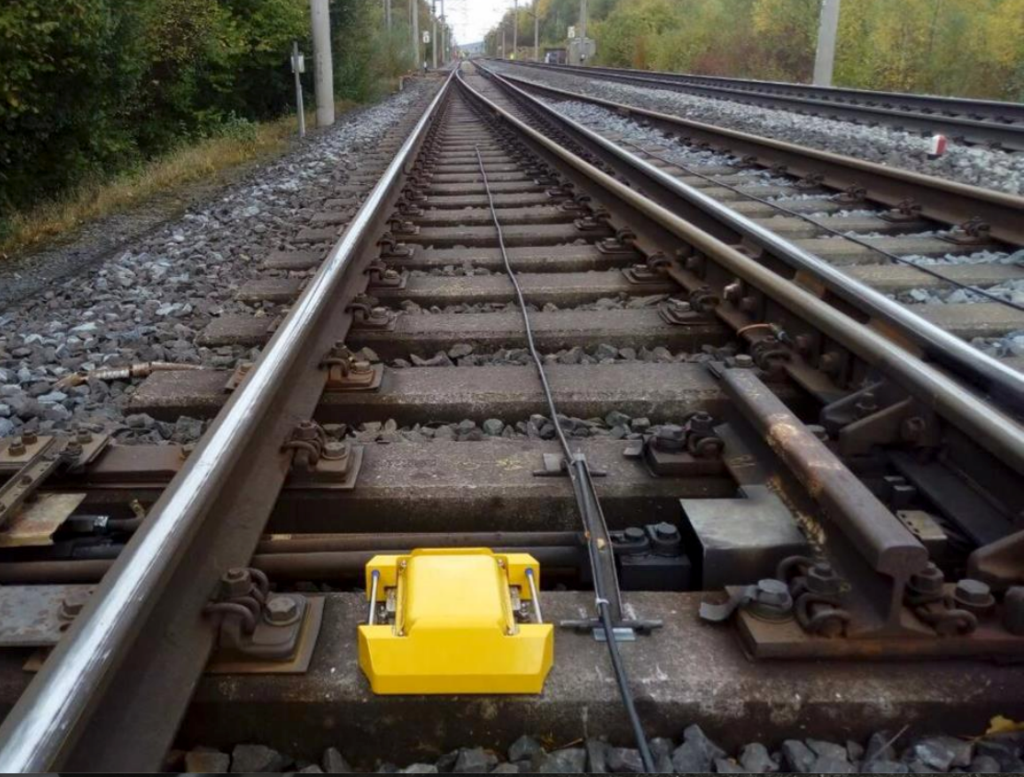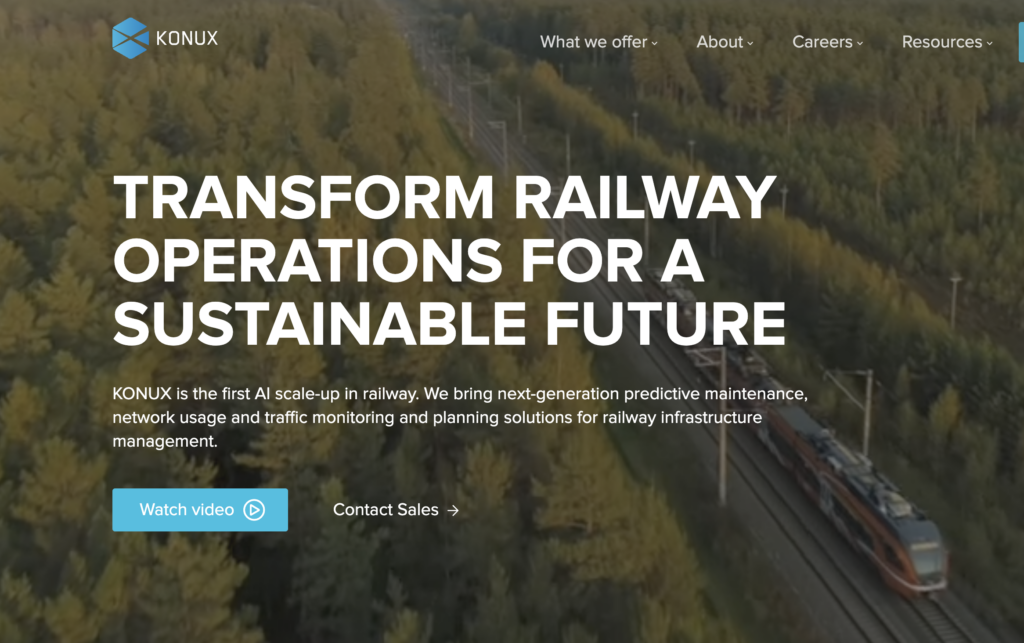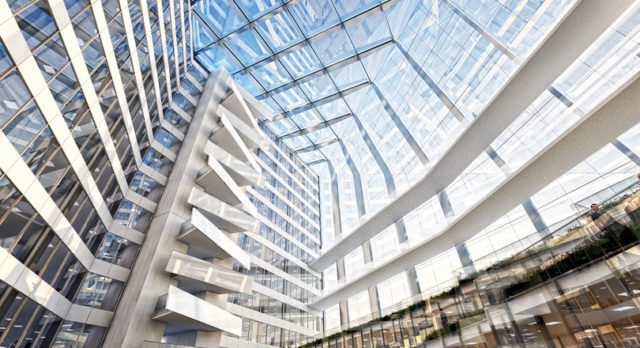Even if you have been on an extended digital detox this year, you likely know of the hype surrounding AI technology. In particular, there has been a large focus on generative AI tools such as ChatGPT and DALL-E. However, Konux scaling AI, a Munich-based deep-tech, has been making progress in the industry by using machine learning to revolutionize transportation on railways.
It is constructing a Software-as-a-Service (SaaS) company fueled by customized sensing hardware and Artificial Intelligence (AI). This predictive maintenance solution is improving railway infrastructure, beginning with the implementation of switches.
The mission of this project is to use cutting-edge AI and IoT technologies to revolutionize the railway industry and make rail travel the most sustainable and advanced mass transit option available. By collecting real-time data on the railway network, the project aims to digitize and transform the way rail travel is managed.
At a time when people are looking for more eco-friendly ways to travel, the demand for trains is increasing. Governments and railway operators are taking advantage of this situation and are using newer technologies to digitize their networks and transform their existing processes. This is providing startups with plenty of chances to jump in and make a difference, and Konux believes that they were the first to do so.
” No surprise then that Konux, a Munich-based startup that uses artificial intelligence to monitor and analyze railway infrastructure, was founded in Germany – a country where the question of whether trains are running well and on time is a perennial political issue.
The challenge lies in making sure that sensors can withstand the environment, collecting the data, interpreting it, applying it to the business challenges, understanding the customer’s needs, and helping the organization navigate through the necessary changes. By addressing these hurdles, you can ensure that the change is meaningful and leave a lasting mark.
Konux utilizes deep technology and resilient connected hardware to gain enhanced insight into the daily loads and forces railroad tracks are subjected to. Vibration is monitored to detect any anomalies that could indicate impending failure and then a probabilistic analysis of the upcoming months is provided regarding the infrastructure.
Bonnifield’s AI-driven predictions boast a 90% accuracy rate, making them a reliable and useful resource for railway operators. The technology provides predictive maintenance insights through a user-friendly software interface, streamlining the process of managing essential infrastructure.
By using track-mounted sensors and machine learning models, operators can now make more informed decisions around maintenance, eliminating the need for “flying blind with scheduled guesswork.” Konux has spent the last decade or so gathering and analyzing billions of train traces, making this data-driven approach possible. If successful, this application of AI should result in decreased service downtime, fewer delays, and an overall improved passenger experience.
Forget the broad, unfocused application of AI; Konux’s combination of AI and the Internet of Things (IoT) offers a far more innovative and impressive engineering solution for railway operators. This data-driven approach provides meaningful insights into predictive maintenance, network traffic, usage and even scheduling.
Konux offers a variety of AI- and IoT-driven products to optimize rail operations, including the Konux Switch (predictive maintenance), Konux Network (usage monitoring and inspection planning), and Konux Traffic (smarter timetabling). These products use data-driven insights to improve the tracking of infrastructure stress at critical points of the network.
Switches are essential for routing train traffic around a network, yet they are prone to failure due to their mechanical components. According to Bonnifield, the company is looking to develop more products as it further investigates what is taking place on the railway.
Overall, Konux’s AI- and IoT-enabled digitization of the railway has the potential to revolutionize the railway system. By eliminating the need for unplanned maintenance, Konux’s system could double the capacity of existing train tracks, unlocking a significant amount of unrealized capacity.
If we are to avoid a climate disaster, it is essential that we find ways to optimize existing low-carbon forms of transportation without having to physically expand railway infrastructure.
This is precisely what companies like Konux are working towards, and with the additional performance they are already able to achieve, the future looks promising. Although currently only monitoring a small proportion of the railway networks, Konux is aiming for full digitization and maximum impact.
Bonnifield emphasizes the potential of Konux to dramatically increase passenger and cargo throughput while also ensuring safety. He explains that the main issue with railway networks is the lack of visibility into their operations, but that Konux’s technology has the potential to change this. With it, railway operators will have increased visibility into their networks, which will allow them to run more efficiently and safely.
They created the timetables, maintenance and inspection regimes, all based on assumptions and predictions of how they should be planned in a network. Additionally, he remarked that it is uncommon to find a company that can confidently say it will be a major force in saving the planet if successful.
” The work we are doing today has a direct link to the impact it can have, making the power of AI a very encouraging notion.
Rail operators often lack visibility into the condition of the tracks, leading to delays that can become major bottlenecks, causing operational disruptions that result in significant delays for passengers. For example, a five-minute late train can quickly become a 50+ minute delay.
Konux believes that by giving operators greater visibility into their networks, dynamic traffic management can become a reality, leading to fewer delays and shutdowns, and allowing for more reactive and dynamic train routing, unlocking substantial capacity wins for the rail system.
Through the use of dynamic speed-per-weight recommendations for loaded trains, it is possible to minimize wear and tear on the tracks. This approach to traffic management requires a substantial amount of data concerning the network to be gathered in order to accurately solve the hard optimization problem that this entails. According to Bonnifield, this is a unique way of tackling the issue.
“This means we need to think differently about how we manage [rail network disruption] from a passenger perspective. This can be a game changer for how we get people on the right train at the right time. Passengers only need to know that the train to London is always on time, but from the perspective of the operators, a different approach is required.”
There must be a strong effort to make rail transportation the preferred mode of mobility. Currently, there is no solution for this, as we cannot construct more tracks in Europe. We must develop a new approach to operating and maintaining rail networks to address this issue to fill the missing capacity. This is the major issue motivating the people working in this company, as we recognize that accomplishing this is essential to reaching our global climate targets.
This is seen as a crucial component of the various transformations that must occur in order to make our desired future a reality.
Railway operators have traditionally had limited knowledge of the details concerning the operations of their networks, such as the speed and weight of trains passing through switches. This has prevented them from accurately assessing the strain on the more fragile areas of the system, creating difficulties in predicting potential infrastructure malfunctions.
This is where Konux’s proprietary sensing hardware can be found – providing an innovative solution to a long-standing railway industry problem.
The data collected at the ground level is used as input for Konux’s AI models to forecast the status of the monitored component in the near future. Its Switch product, specifically, is capable of predicting the condition of switches in the following 90 days, allowing operators to recognize deterioration at an early stage. As a result, they can plan inspections and prioritize maintenance based on the actual network utilization.
Bonnifield states that the detection of the load factor and speed of certain trains can be a game-changer when it comes to their management and operation. By having access to the underlying reality of what is happening on the network, having this real data can make all the difference in high-stress, high-energy cases that can cause destruction to the network.
” Giving those who are working heroically on these networks a better outlook of what is occurring, and making reliable predictions on how they should change their methods, are the main contributors to the 50% additional capacity.
Konux supplements its track-level data with additional sources of open and third-party information, such as temperature at a particular location, along with visual data from partner companies that have cameras mounted on trains. This allows them to do a visual assessment of any assets that their sensors have indicated may be deteriorating.
We want to be the intelligent processing center that empowers rail operators to gain better visibility into their networks and make data-driven decisions that will improve the efficiency of their operations.”
We created a revolutionary sensing device specifically tailored to the requirements of an AI company. We are open to gathering and integrating data from any source, regardless of its origin, as long as it is useful. Solving this challenging sensing problem was a major undertaking, and we are proud to have been the first to successfully do it.
“If it was easy to acquire the data and someone else had already done it, we would have approached the situation differently. At the end of the day, we aim to be the brains of the network, not the hands or the legs.”
” Rather than requiring someone to survey each component of their network, we can do it automatically. We can provide a visual representation of any issues and alert the user when there is a problem. We can even provide recommendations to optimize the user’s resources. In this way, we can maximize the efficiency of their efforts.
Konux was established in 2014, when its founders dreamed of using AI in demanding industrial settings. This ambitious startup chose the railroad industry as its battlefield and has since become a robust scale-up, having accumulated $130.6 million in investments (including a $80M Series C in January 2021). So far, it has tried and implemented its products in over ten markets.
Konux invested years of research and development into creating their predictive AI models. This involved deploying prototypes and testing the hardware in multiple countries and railway operating conditions, allowing them to collect a wide range of data to create a model that works in “any environment,” as Bonnifield describes it.
This proves to be a difficult task as it is difficult to determine whether the AI models we construct are overfitted to a particular setting or certain dynamics. Therefore, our main focus is the data we have gathered, our understanding of the data, and the whole pipeline that oversees it,” he concluded.

Konux has already installed its connected devices on railways in China, India, and Japan, and is now expanding its reach to its home market of Germany with Deutsche Bahn (DB). In late 2020, Konux was successful in a long-term framework agreement tender for the digitization of switches with DB. This will allow the company to further its efforts in the digitization of the railways in Europe.
This company is set to experience a major transformation, with an increase from 1,000 of its sensing devices deployed on train tracks around the world to 3,500 being installed in Germany on the busiest parts of DB’s rail network in the next year. This will bring the total operational footprint to 10 times its current size. According to Bonnifield, “This is going to be this incredible step-change for this company.”
For the past eight years, I have been instrumental in pioneering organizational changes and resolving the technical issues needed to introduce next-generation AI and IoT into this industry. We are now ready to roll out these advances at scale in the main corridor of Germany’s largest and busiest European rail network.
He rattles off a comprehensive list of accomplishments Konux had to achieve in order to reach their current milestone. This includes being the first company to certify an IoT device and the first AI firm in rail. Moreover, they were the first tech start-up to be given a rail tender and the first to secure a SaaS contract with a rail network, which is drastically different from the costly capital investments transport companies were normally accustomed to.
”He says, referring to the process of getting government approval for their AI models. “We had to invent standards for assessing the performance of our AI models since nothing like this had been done before. We had to figure out what predictive maintenance meant, and how we could predict the future. All of this was totally new and novel to the industry.”
Bonnifield expresses amazement at the massive effort that went into building both a deep tech company and an organisational transformation company, culminating in a large-scale rollout. “It’s incredible,” he says.
Our aim is to prove that the DB expansion is capable of functioning effectively on a large scale, especially in the most critical areas of the most prominent European railway system. This demonstration will serve as a powerful statement of our confidence in this solution and our belief that it is the most reliable and efficient method.
Our job is to make it easier for them to get on board with this overhaul of how they monitor and maintain fixed infrastructure, while still maintaining a safe environment. It’s an immense, ongoing business transformation.”
The challenge is to find a way to innovate while still maintaining those safety protocols and regulations. The current crisis has led organizations to attempt to find a way to balance innovation and safety in order to survive.”
That they’re secure. To make that happen, we need a step-by-step, carefully planned revolution in order to successfully pass through all of the necessary changes.”
This was done to demonstrate that our approach is viable from a business standpoint. We wanted to show that our approach can work within the existing operational models of rail networks and that it can provide real value.”
” We were held to a 90% accuracy standard, which is a very difficult benchmark to reach when trying to predict the future. We had to demonstrate that our AI models worked not just adequately, but spectacularly well—almost perfectly—before we could justify rolling them out on thousands of devices across the nation.
Artificial Intelligence that has been extensively trained, tested, and perfected over an extended period of time to meet the requirements of government regulations and deliver accurate predictions that can lead to increased productivity is a technology that should be given serious consideration by the global community.
The next phase of Konux’s database deployment will enable it to monitor 15% of the important network resources of a major railway operator in its native market. While this is still far from its goal of achieving complete network coverage in Germany and beyond, the company has made significant strides after years of hard work establishing the fundamentals of its digital transformation. These efforts have put Konux in a great position to continue its expansion and growth.
Europe is the startup’s main focus for now, as Bonnifield calls it an “incredible proving ground” for its tech due to the high demands for safety and performance, as well as the railways’ regional political importance. As befits any ambitious scale-up, Konux has big plans for international expansion, aiming to bring its tech to markets in North America, Latin America, and Asia.



